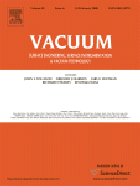|
Literature / Source Database:
Vacuum
Description
surface engineering, surface instrumentation & vacuum technology
| Title (short) |
Vacuum |
| CODEN |
VUCUAV |
| Languages |
English |
| First year |
1951 |
| Impact factor |
1.558 |
| Editor |
J.S. Colligon, G.J. Exarhos, L.G. Hultman, R.E. Hurley, K. Wasa |
|
|

|
Status
active
Indexing
Cambridge Scientific Abstracts; Chemical Abstracts; Computer Contents; Current Contents/Engineering, Computing & Technology; Current Contents/Physics, Chemical, & Earth Sciences; Current Contents/SciSearch Database; Current Contents/Science Citation Index; Current Technology Index; Engineering Index; INSPEC; PASCAL/CNRS; Research Alert; Scopus
Subject

Source type
Journal
Publisher
ISBN ISSN
0042-207X
First volume
1
Last volume
82+
| Resources |
|
Availability |
|
|
|
|
|
| Text PDF |
 |
free access |
 |
| Text Html |
 |
for subscriber |
 |
| References |
 |
not available |
 |
| Abstracts |
 |
|
|
| TOC |
 |
|
|
|
|
|
|

Description
The international journal Vacuum publishes high quality papers on latest advances in the many areas which now require the production and control of a working environment at pressure below one atmosphere.
The topics covered by the journal are thus truly interdisciplinary and papers cover the interests of many groups, ranging from fundamental vacuum science to industrial systems and processes. This includes vacuum specialists, engineers, physicists, surface scientists, chemists, electronic device specialists, materials scientists.
Typical papers cover new developments in vacuum pumping and instrumentation, vacuum measurement, kinetic theory, gas-surface interactions, surface analysis, plasma and ion-surface interactions and etching, nanometer-scale processing, ion implantation, surface modification and coating industry, PVD, CVD and ion/plasma-assisted PVD/CVD.
The journal Vacuum welcomes concise papers, short communications and reviews in the above areas and will normally publish those meeting strict refereeing standards promptly after delivery of the manuscript to one of the Editors listed inside the front cover. Details on style and submission are given inside the back cover of the journal.
Related links:
|